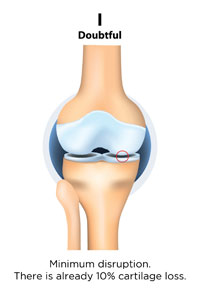The knee is the largest and strongest joint in your body. It is made up of the lower end of the femur (thighbone), the upper end of the tibia (shinbone), and the patella (kneecap). The ends of the three bones where they touch are covered with articular cartilage, a smooth, slippery substance that protects and cushions the bones as you bend and straighten your knee.
Osteoarthritis is the most common form of arthritis in the knee. It is a degenerative, “wear-and-tear” type of arthritis that occurs most often in people 50 years of age and older, but may occur in younger people, too.
In osteoarthritis, the cartilage in the knee joint gradually wears away. As the cartilage wears away, it becomes frayed and rough, and the protective space between the bones decreases. This can result in bone rubbing on bone, and produce painful bone spurs.*

Stage 1 (Doubtful) OA; Minimum disruption. There is already 10% cartilage loss. Very likely, a person with stage 1 osteoarthritis, is not experiencing any pain or discomfort as a result of the very minor wear on the components of the joint.

Stage 2 (Mild) OA; Joint-space narrowing. The cartilage to begin breaking down. Occurrence of osteophytes. This is the stage where people may first begin experiencing symptoms. Pain after a long day of walking or running, greater stiffness in the joint when it’s not used for several hours, tenderness when kneeling or bending.

Stage 3 (Moderate) OA; Moderate joint-space reduction. Gaps in the cartilage can expand until they reach the bone. People with stage 3 OA of the knee are likely experiencing frequent pain when walking, running, bending, or kneeling.

Stage 4 (Severe) OA; Joint-space greatly reduced. 60% of the cartilage is already lost. Large osteophytes. People in stage 4 OA of the knee experience great pain and discomfort when walking or moving the joint.**


